
Ice hockey is a team sport played on ice skates, usually on an ice skating rink with lines and markings specific to the sport. It belongs to a family of sports called hockey. In ice hockey, two opposing teams use ice hockey sticks to control, advance, and shoot a closed, vulcanized, rubber disc called a "puck" into the other team's goal. Each goal is worth one point. The team which scores the most goals is declared the winner. In a formal game, each team has six skaters on the ice at a time, barring any penalties, one of whom is the goaltender. Ice hockey is a full contact sport, and is considered to be one of the more physically demanding team sports. It is distinct from field hockey, in which players move a ball around a non-frozen pitch using field hockey sticks.

In many team sports that involve scoring goals, the goalkeeper is a designated player charged with directly preventing the opposing team from scoring by blocking or intercepting opposing shots on goal. Such positions exist in bandy, rink bandy, camogie, association football, Gaelic football, international rules football, floorball, handball, hurling, field hockey, ice hockey, roller hockey, lacrosse, ringette, rinkball, water polo, and shinty, as well as in other sports.

Box lacrosse, also known as boxla, box, or indoor lacrosse, is an indoor version of lacrosse played mostly in North America. The game originated in the 1930s in Canada, where it is more popular than field lacrosse. Lacrosse is Canada's official national summer sport. Box lacrosse is played between two teams of five players and one goalie each, and is traditionally played on an ice hockey rink once the ice has been removed or covered. The playing area is called a box, in contrast to the open playing field of field lacrosse. The object of the game is to use a lacrosse stick to catch, carry, and pass the ball in an effort to score by shooting a solid rubber lacrosse ball into the opponent's goal. The highest level of box lacrosse is the National Lacrosse League.

A penalty kick is a method of restarting play in association football, in which a player is allowed to take a single shot at the goal while it is defended only by the opposing team's goalkeeper. It is awarded when an offence punishable by a direct free kick is committed by a player in their own penalty area. The shot is taken from the penalty spot, which is 11 m from the goal line and centred between the touch lines.

In ice hockey, a goal is scored when the puck entirely crosses the goal line between the two goal posts and below the goal crossbar. A goal awards one point to the team attacking the goal scored upon, regardless of which team the player who actually deflected the puck into the goal belongs to. Typically, a player on the team attempting to score shoots the puck with their stick towards the goal net opening, and a player on the opposing team called a goaltender tries to block the shot to prevent a goal from being scored against their team.
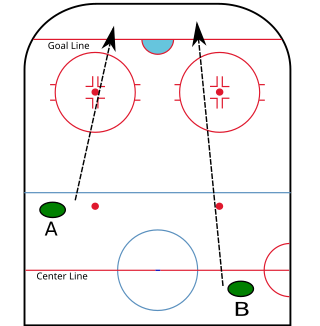
In ice hockey, icing is an infraction when a player touches the puck over the center red line and the opposing team's red goal line, and the puck remains untouched without scoring a goal.
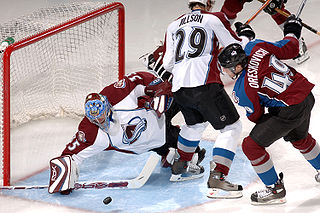
In ice hockey, the goaltender is the player responsible for preventing the hockey puck from entering their team's net, thus preventing the opposing team from scoring. The goaltender mostly plays in or near the area in front of the net called the goal crease. Goaltenders tend to stay at or beyond the top of the crease to cut down on the angle of shots. In the modern age of goaltending there are two common styles, butterfly and hybrid. Because of the power of shots, the goaltender wears special equipment to protect the body from direct impact.

A penalty in ice hockey is a punishment for an infringement of the rules. Most penalties are enforced by sending the offending player to a penalty box for a set number of minutes. During the penalty the player may not participate in play. Penalties are called and enforced by the referee, or in some cases, the linesman. The offending team may not replace the player on the ice, leaving them short-handed as opposed to full strength. When the opposing team is said to be on a power play, they will have one more player on the ice than the short-handed team. The short-handed team is said to be "on the penalty kill" until the penalty expires and the penalized player returns to play. While standards vary somewhat between leagues, most leagues recognize several common varieties of penalties, as well as common infractions.
In ice hockey, a penalty shot is a type of penalty awarded when a team loses a clear scoring opportunity on a breakaway because of a foul committed by an opposing player. A player from the non-offending team is given an attempt to score a goal without opposition from any defending players except the goaltender. This is the same type of shot used in a shootout to decide games in some leagues.
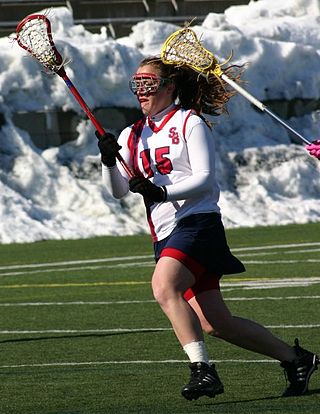
Women's lacrosse, sometimes shortened to lax, is a field sport played at the international level with two opposing teams of ten players each. Originally played by indigenous peoples of the Americas, the modern women's game was introduced in 1890 at the St Leonard's School in St Andrews, Scotland. The rules of women's lacrosse differ significantly from men's field lacrosse. The two are often considered to be different sports with a common root.

Roller in-line hockey, American roller hockey or inline hockey, is a variant of hockey played on a hard, smooth surface, with players using inline skates to move and ice hockey sticks to shoot a hard, plastic puck into their opponent's goal to score points. The sport is a very fast-paced and free-flowing game and is considered a contact sport, but body checking is prohibited. There are five players including the goalkeeper from each team on the rink at a time, while teams normally consist of 16 players. There are professional leagues, one of which is the National Roller Hockey League (NRHL). While it is not a contact sport, there are exceptions, i.e. the NRHL involves fighting.

High-sticking can refer to two infractions in the sport of ice hockey.

The National Hockey League rules are the rules governing the play of the National Hockey League (NHL), a professional ice hockey organization. Infractions of the rules, such as offside and icing, lead to a stoppage of play and subsequent face-offs, while more serious infractions lead to penalties being assessed to the offending team. The league also determines the specifications for playing equipment used in its games.
This is a list of common terms used in the sport of ice hockey along with the definitions of these terms.

An empty net goal, abbreviated as EN or ENG and colloquially called an empty netter, occurs in several team sports when a team scores a goal into a net with no goaltender (goalie) present.
The Hockey Canada Officiating Program is the governing body for on-ice officials for all ice hockey games played under the jurisdiction of Hockey Canada. The Hockey Canada Rulebook provides in-depth explanation and examples of all rules governing hockey in Canada.
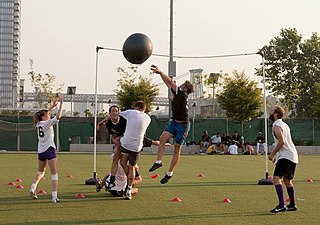
Circle rules football, commonly referred to as circle rules, is a team sport played between two teams of six with a large spherical ball similar to a stability ball. Invented in New York City in 2006, the sport is currently played in cities across the United States, as well as in several international locations.
In ice hockey, an awarded goal is an unusual situation in which a goal is awarded to a team rather than scored. A penalty shot is a type of penalty awarded when a team loses a clear scoring opportunity on a breakaway because of a foul committed by an opposing player. A player from the non-offending team is given an attempt to score a goal without opposition from any defending players except the goaltender. However, when such a lost opportunity occurs and the opposing team has pulled its goalie to allow for an extra attacker, a goal is simply awarded without a penalty shot taking place.
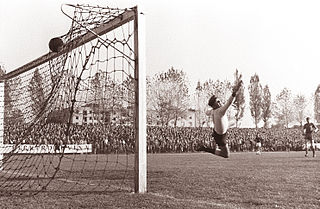
In games of association football, teams compete to score the most goals during the match. A goal is scored when the ball passes completely over a goal line at either end of the field of play between two centrally positioned upright goal posts 24 feet (7.32 m) apart and underneath a horizontal crossbar at a height of 8 feet (2.44 m) — this frame is itself referred to as a goal. Each team aims to score at one end of the pitch, while preventing their opponents from scoring at the other end. Nets are usually attached to the goal frame to catch goalscoring balls, but the ball is not required to touch the net.

A free kick is a method of restarting play in association football. It is awarded after an infringement of the laws by the opposing team.















